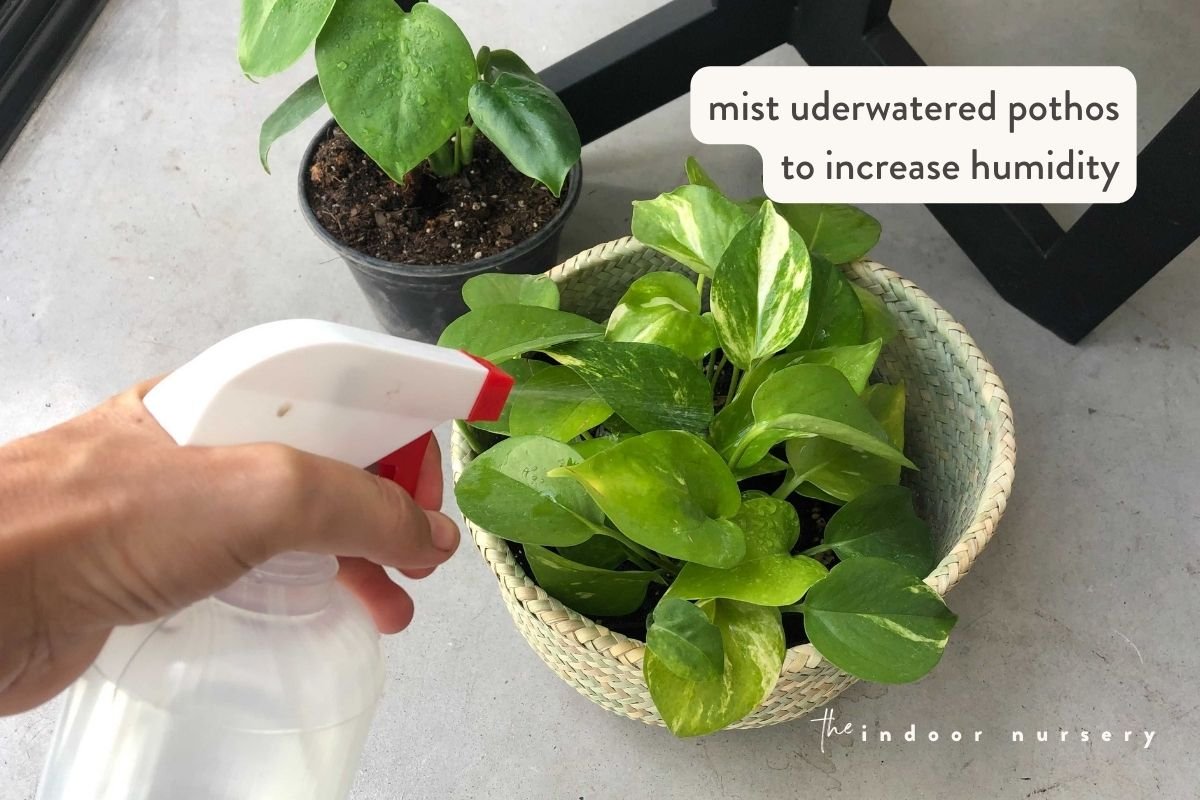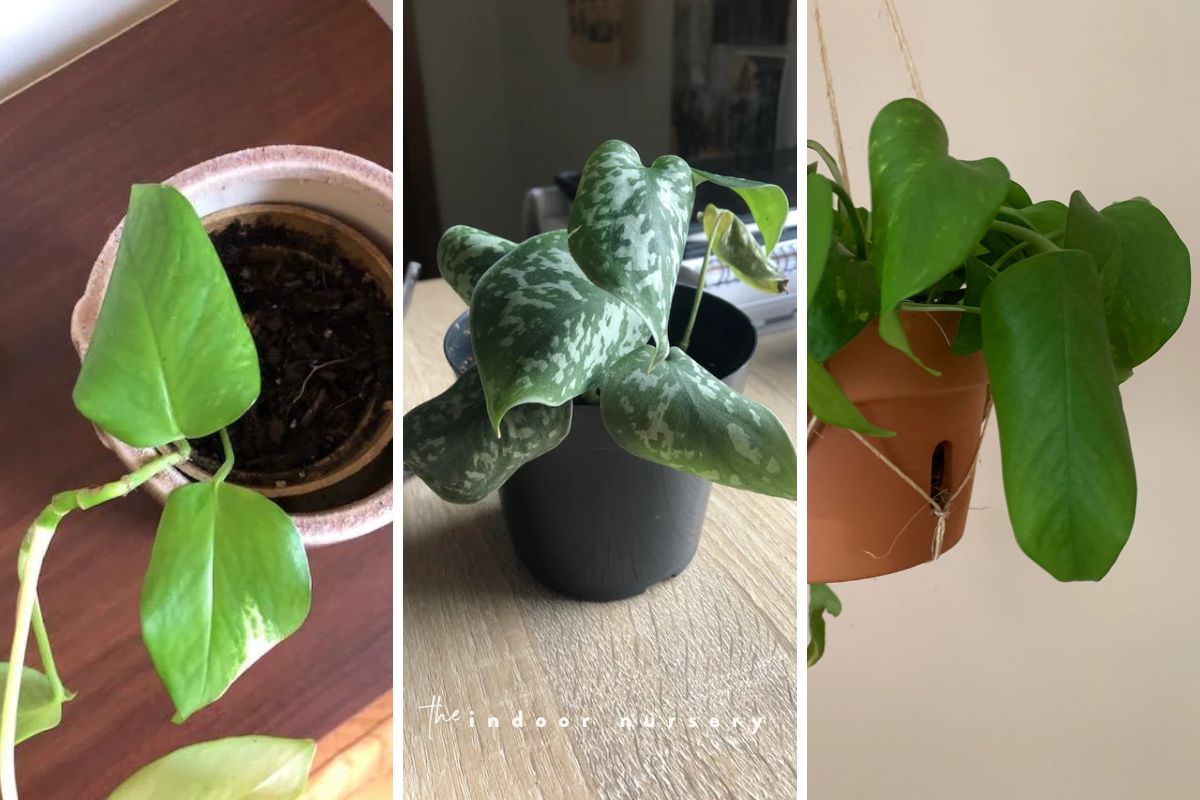A pothos is among the easiest houseplant types to care for, and it’s one of those indoor plants that can be generally left alone and still do just fine. Giving a pothos its space allows the soil to dry out between waterings, but too much neglect can be damaging to the plant’s health. One of many signs the plant needs a little more attention is curled leaves.
Why are the leaves of my pothos curling?
Pothos has wide, firm, flat leaves, and curling is a sign of stress. When pothos leaves curl, it usually means the plant is dehydrated, but there’s more to it than that. A plant can dehydrate in different ways, from either, or both, care and environmental factors.
If you’re noticing your pothos leaves are starting to curl, it’s time to examine the plant and soil, to think about your watering schedule, and consider whether the plant’s current location is the right one. When its living conditions are right, pothos will be able to coexist with relatively little intervention.
Too little water
One of the reasons pothos plants are so easy to care for is that they don’t need to be watered too frequently. Just once every week or two should be enough for a pothos, but this will vary by individual specimen. The size of the plant and its pot, as well as its location in a room, affects just how much water a given plant may need. A fast growing plant that gets lots of direct sunlight can use (and lose) water more quickly than a slow growing plant, or one that doesn’t get a ton of light.
When a plant doesn’t get enough moisture, it starts to tap internal reserves, and curling is the result. If you’re noticing curling leaves despite giving what you think should be enough water, check the soil: pothos like to become root bound and this tends to take up more space, and as the soil gets broken down and depleted, there is less to hold water. While multiple plants like to live in a pot, too many can get crowded and may need to be split up and/or moved into larger pots with fresh soil.
Read more: how to save an underwatered pothos
Old leaves dying off
Dehydrated plants will do what they can to save their roots and healthiest growth, and curled leaves may be the first to go when conserving resources, allowing the weaker leaves to dry up and drop off. A pothos that isn’t getting enough light may also sacrifice some leaves to be more efficient with the energy it does receive. Moving it into brighter, indirect light and making sure the watering schedule is right for its size will help the plant recover. Dead leaves and stems should be trimmed and removed from the pot since they provide cover for spiders and other small pests.
Too much water
Sometimes pothos’ leaves start to curl and droop, a sign the roots are damaged and unable to absorb moisture or oxygen. A plant that gets watered too much can succumb to root rot in waterlogged soil. If you water your pothos more than once a week, allow the soil to dry out before starting a new schedule of once every two weeks. It’s better to underwater a pothos, from which it can quickly recover, than overwatering. A well-draining soil and a pot with drainage holes will help be sure the soil dries out properly.
Read more: how to save an overwatered pothos
Dry climate
Pothos are originally from the rainforests of Polynesia, growing in the understory on the trunks of trees. These forests are warm and humid, so too dry of an environment will dehydrate a pothos plant. They like an environment with a humidity level between 50-70%. The average home usually has a humidity level between 30% and 50%, so a humidifier might be necessary to keep your pothos happy and hydrated.
Too much fertilizing
Being from the rainforest, pothos are conditioned for a nutrient-rich topsoil that is regularly replenished. In nature, the warm forest floor is regularly turning over organic matter from the abundance of animals, insects, and vegetation that build its nutritious soil. For this reason, pothos should be given solid fertilizer once or twice a year, or a low dosage of liquid fertilizer regularly, heavily diluted in water (a half or quarter amount every month or two in spring and summer should be enough to support growth).
Too much fertilizer, however, can result in stress on the plant. If too much synthetic fertilizer is used, it can damage the roots since these formulas are usually heavy in salt forms of a particular nutrient. Even too much organic fertilizer can overwhelm the plant or change the soil pH in detrimental ways. If your pothos leaves are curling, dropping, or dying off, consider your fertilizing schedule and check the soil pH and nutrient levels to make sure everything is well-balanced.
Too hot
If your home is too warm, your pothos’ leaves might start curling as it tries to conserve moisture and stave off heat stress. Like a too-dry environment, a too-hot environment can result in moisture loss in the soil and in the plant tissue. Warm air holds more moisture and encourages evaporation. Plants transpire and release moisture regularly, but when it’s too hot, that transpiration process may accelerate as the warm air pulls water from the plant. Keeping the plant out of the sun will help keep it cool and using a fan or air conditioner can help lower temperatures. Even though pothos is a tropical plant, it can still get overheated.
Too much light
Pothos grow on tree trunks in the understory of the rainforest, where they receive light filtered through and shaded by the canopy. This gives it a reputation for being a low-light plant, and while pothos are able to tolerate some shade, they prefer to have lots of indirect light exposure.
Direct light can result in the leaves curling from dehydration, or their edges turning brown from moisture loss or from leaf burn. Leaves might also curl upward to hide its surface from the sun as a defense mechanism against too much sunlight.
If your pothos is in a window or in a spot that receives direct sunlight, move it to another place nearby where it gets lots of indirect light while also being shaded from the sun.
Disease or pest infestation
Some of these environmental conditions that lead to curled leaves can also result in habitat conditions for pests or infection by soil fungus or mildew. Dry, dead leaves in a bushy pothos provide shade and cover for small insects, particularly spiders and spider mites. Too-moist conditions can lead to mildew growth on leaves, or fungal growth in the soil that competes for nutrients and damages the roots. Fungus gnats may also be a problem when too-wet soil encourages fungus in the soil. Pruning a pothos as necessary, removing dead leaves, and keeping the soil just moist enough to keep the plant healthy will lower the potential for pests or disease to take hold.
Read more: what to do with scale on pothos plants

General pothos plant care tips
Having a streamlined care routine for your pothos will take the guesswork out of keeping it healthy throughout the year. Here are a few tips to maintaining your pothos in its top condition:
- Water once every week or two. Pothos plants get some of their moisture from the air, and don’t need to be watered as often as other kinds of houseplants. It’s better to underwater than overwater a pothos, so be sure the soil almost dries out completely before watering. Read more: how often to water pothos plants
- Prune and trim as necessary. As a vine, a pothos plant will grow long and leggy if it isn’t getting enough light, and sometimes it’s best to cut these long stems back to keep it bushy, with full leafy coverage. Dead stems and leaves should be removed right away to avoid pests or disease taking advantage, and to avoid dead foliage crowding out healthy growth.
- Put them in bright, indirect sunlight. Like most plants, pothos do best with lots of light, but since they’re understory plants in the wild, they’re not used to direct sunlight. Direct sun can burn the plants and dehydrate them, so it’s best to keep them in an area that gets indirect light throughout the day. Read more: indoor lighting guide: where to put your plants
- Monitor the humidity. In the rainforest, photos receive lots of moisture from the air in addition to root-absorbed water from the ground. If it gets too dry, the plant will dehydrate and curl, droop, or wilt. If it’s in an area drier than 50% humidity, a humidifier can help keep the plant in firm, hydrated form.
- Fertilize in low doses regularly during growing seasons. The rainforest floor is rich in nutrients, and pothos are used to a regular supply of fertilizer. A small, regular dosage every month or two will keep the plant in its best condition, especially during the growing seasons. As a tropical evergreen, some growers still give their pothos a low dose of pothos fertilizer every couple of months during the cooler months if the plant is growing. If growth slows or stops, however, adding any excess nutrients may go unused and can be damaging for the plant.
- Use a moss pole. A pothos will love to attach itself to a moss pole, as a supportive structure and a source of moisture. One way to avoid overwatering is by using a moss pole, which will hold water longer, and the plant can absorb it as needed. The pole will also allow the plant to grow upwards as it would along a tree trunk in nature.
- Create the right soil mixture. I like to make a potting soil mix for pothos plants that allows proper drainage but doesn’t dry out too much.
Closing thoughts
Pothos plants are loved for their ease of care and bushy, year-round greenery. It’s one of those plants that likes to be left alone, but likes some attention now and then. If you follow a regular schedule, you’ll only need to give it a little care once every week or two, and a healthy pothos will take care of itself the rest of the time!
More about pothos
- How Often To Water Pothos Plants (And When To Cut Back)
- Marble Queen Pothos Care Guide
- How To Make Pothos Fuller (In 5 Minutes)
- Our top pothos fertilizer picks for luscious vines
- Golden Pothos plant care: how to keep them happy
- Pothos root rot: what to look for and how to fix it
- How to grow pothos in water for *decades*

